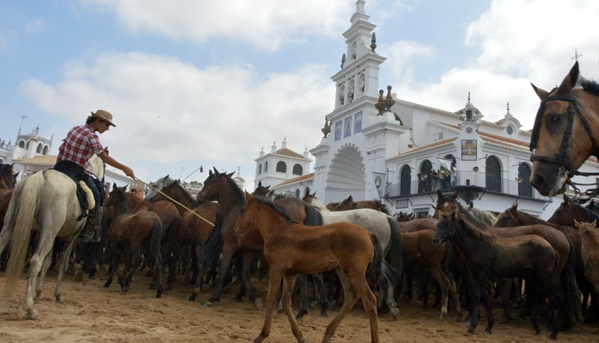Simply Beautiful
Almonte, an Andalusian town with more than 20,000 inhabitants, is located between the wine-growing countryside of the Huelva county and the famous Guadalquivir marshes. The horizontal landscape, the sun, the light and the sea salt have given these lands the special charm of beauty in its simplicity. Vineyards and olive groves, holm oaks and pines, preserves, dunes, marshes and beaches come together in this border corner of old Andalusia, breaking traditional labels and stereotypes, to offer the visitor a new face of the south. Imbued with Mediterranean and Atlantic sauce, it is characterized by tranquillity, joy, calm and the transmission of a centuries-old way of living.
Almonte has always lived from agriculture, livestock and the traditional uses that its rich natural heritage provided: hunting, agriculture, coal, pines, etc. It offers the possibility of growing products that have no competitors in the market internationally, based on its valuable denomination of origin. There is an emphasis placed on the traditional agriculture that coexists with modern agriculture. It has also always been a crossroads point between the provinces of Huelva, Seville and Cádiz, which undoubtedly must have contributed to the open and hospitable character of its people. The zealous conservation and transmission of old traditions, such as the Pilgrimage of Rocío or the Round-up of Mares, means Almonte today offers valuable tourist attractions for any foreigner. Holy Week, the patron saint festivities or the Saint Peter Fair, which are celebrated after the arrival of the mares on June 26, are very popular in the area. In the town of Almonte notable buildings stand out. The Parish Church of the Assumption, in the Town Square, stands out due to the whiteness of its façade; It owes its current appearance to the reconstruction after the Lisbon earthquake in 1755. Baroque in appearance, it is flanked by two bodies of bells, and to the right it is adorned with a coquettish belfry. A high tower on the left allows us to glimpse a cupola with a lantern of classical style. The Town Hall (16th century) was inaugurated in 1612 and, two years later, the construction of the second floor of the building was approved. In 1795 it was remodeled, acquiring the aspect that it presents today. It has two floors that rest on lowered semicircular arches; highlighting the blacksmithing. It was restored in 1997, incorporating a series of artistic tiles. You can visit during business hours. We also highlight the Chapel of Christ, the Museum of the Villa, as well as the monument to the Patron Saint of Almonte and Round-Up of the Mares.


In Almonte, we find different elements of historical reference, highlighting the sculpture of the hero of Baler, a neighbor of the town, who was one of the “last of the Philippines”. Throughout the town we will find a set of tiles that reflect moments and places of local history. Three tourist routes cross the town: – The Route of the Virgin, which runs through the same streets as the Virgin in her Return and Procession in Almonte. – The Route of the Mares, through the streets that the mares pass every June 26 on their arrival in Almonte. – The Wood Route, along the route that supports the greatest wine and forestry use. Walking through the town we will find examples of traditional agricultural housing. For recreation, the town of Almonte offers its visitors parks and squares. Of special importance is the Alcalde Mojarro Park which presents, in addition to a wonderful promenade around an artificial lake, a mini-zoo and playgrounds for children. Other areas of interest are the Blas Infante Park and the Plaza Fuente de las Damas.






















